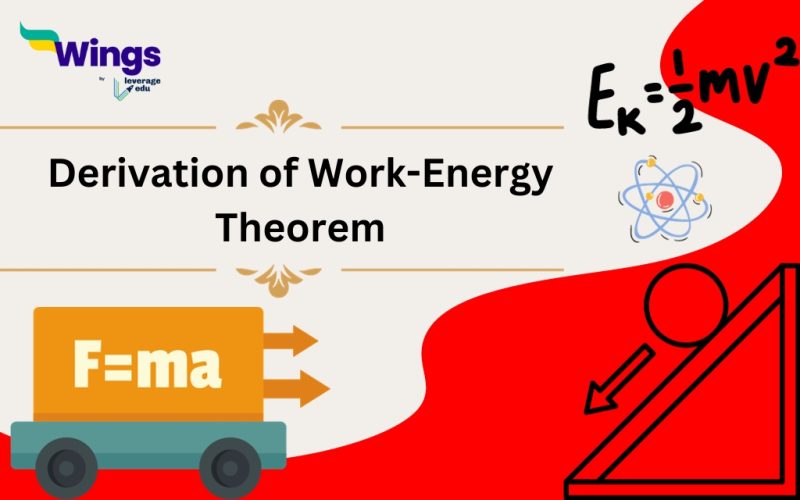We do various activities in our daily life, sitting and reading a newspaper is also doing some work. According to Physics, any work done that does not involve the displacement of the body is not considered work. Thus, to describe the phenomenon of work energy we will derive the work energy theorem. The work-energy theorem explains the reasons behind the physics of no work. Stay tuned and continue reading this article to get the derivation of the work-energy theorem!
Also Read: Class 11 Physics Chapter 3 – Motion in a Straight Line
What is Work?
Work is defined as the product of force and displacement. It means when the force acting on an object displaces the object from its original position, then it is said to be work done.
You must also know that moving objects possess kinetic energy. Thus, the work-energy theorem gives the relationship between work and kinetic energy.
Work is the change in kinetic energy.
W= ΔK
Also Read: Class 9 Motion
Work-Energy Theorem
The work-energy theorem is defined as the work done by the net force applied on an object or body is directly proportional to the change in kinetic energy.
The formula of the Work-Energy Theorem is
Kf – Ki = W
Here,
Kf= Final kinetic energy
Ki= Initial Kinetic energy
Kf – Ki is a change in Kinetic energy
W= Work done on an object
Derivation of Work-Energy Theorem
Equations of motion,
v2 = u2 + 2as
Here,
v = final velocity of an object
u = initial velocity of an object
a = constant acceleration
s = displacement of the object
The above equation can also be written as:
v2 – u2 = 2as
Substituting the values of the vector quantities, the equation would be:
v2 – u2 = 2*a*d
Now, multiply both sides of the equation by m/2, we get:
½ mv2 – ½ mu2 = ma*d
According to Newton’s second law of motion, F= ma,
Now, the above equation can be written as:
½ mv2 – ½ mu2 = F*d
We also know that W= F.d and, Kinetic energy = (mv²)/2,
Thus the equation becomes:
Kf – Ki = W
Hence, we have:
ΔK = W
Here ΔK = Kf – Ki
ΔK= Change in kinetic energy
Also Read: Basic Physics Formulas and Notes for Competitive Exams
Derivation of Work-Energy Theorem for Variable Force
Here is the proof of the work-energy theorem for variable force:
F= Variable Force
t= Time
Work Done by Force is given by:
W= ∫X1X0 F* dx —equation 1
Here,
x0= initial position
x1 = Final Position
We know that,
Kinetic energy KE= ½ *mv2.
This means that when x0 then K0 and when x1 then K1.
Now, differentiate K w.r.t time (t):
dK/dt= m*v* dv/dt
dK/dt=m*a*dx/dt
dK/dt= F*dx/dt
dK= F*dx
∫K0K1 dK = ∫x0x1 F* dx
ΔK = W
Hence Proved.
Also Read: Laws of Motion Class 11
Derivation of Work-Energy Theorem for Constant Force
From Newton’s Second Law of Motion: F = ma
Here,
a = acceleration of the object
The velocity of the object increases i.e. v1 to v2 by applying acceleration, and the object gets displaced by a distance d.
Thus the equation becomes:
v22−v12= 2*a*d
We can also write it as:
a = (v22−v12)/2d, or
Now substituting the value of a in F= ma
F = m (v22−v12)/2d, or
Fd = m (v22−v12)/2d, or
Fd = ½ m*v22 – ½ m*v12 —Equation 1
Fd is the work done by the force F to move the object through a distance d.
In equation 1, the quantity
K2 = m*v22/2 is the final Kinetic energy of the object.
K1=m*v12/2 is the initial Kinetic of the object.
Thus equation (1) becomes
W=K2-K1=ΔK- Equation 2
Here,
ΔK = change in Kinetic energy of the object.
From equation 2, it is clear that the work done by a force is equal to the change in kinetic energy.
Relevant Blogs
| Who is Known as the Father of Modern Politics? | GK Quiz for Class 5 |
| What is the Total Weight of Chandrayaan-3? | World Science Day for Peace and Development |
| National Science Day | National Techies Day |
FAQs
The Formula for the Work-Energy Theorem is W= Kf – Ki
Here, Kf= Final kinetic energy, Ki= Initial Kinetic energy
Kf – Ki is a change in Kinetic energy
W= Work done on an object
The work-energy theorem states that the total work done on an object by the application of force is equal to the change in its kinetic energy.
The derivation of the work equation is W= F*d. Here W= work and it is the product of Force (F) and Displacement (d).
For more information about such informative articles, make sure to check the trending events page of Leverage Edu.
 One app for all your study abroad needs
One app for all your study abroad needs













